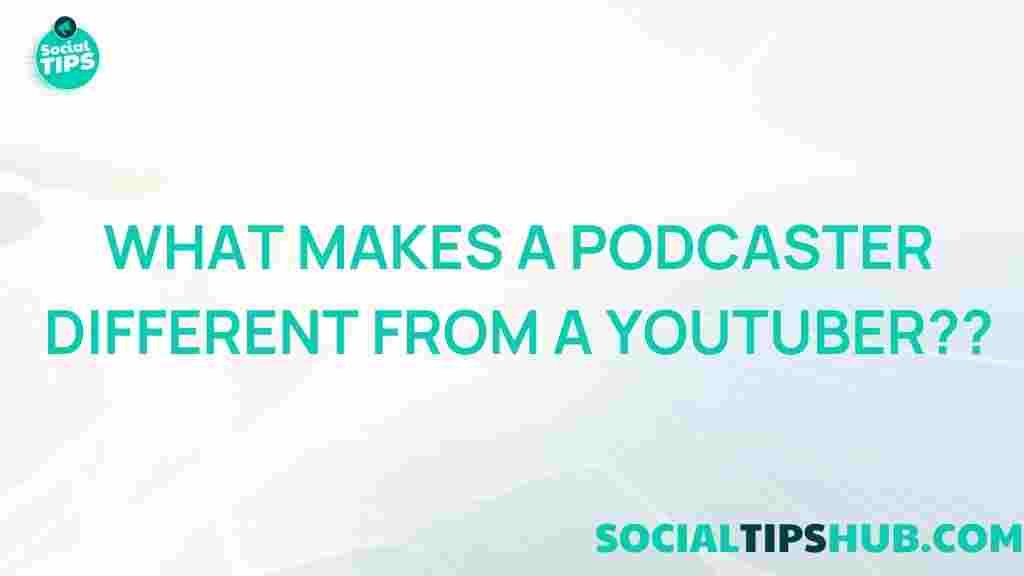Understanding Podcasting: Unraveling the Distinctive Traits of Podcasters and YouTubers
In the digital age, content creation has taken various forms, with two of the most popular mediums being podcasting and YouTube. While both platforms serve the purpose of entertainment and information dissemination, they appeal to different audiences and showcase distinct characteristics. This article delves into the unique traits of podcasters and YouTubers, exploring what sets them apart and how each medium serves its creators and audience.
The Rise of Podcasting
Podcasting has exploded in popularity over the last decade. Initially a niche market, it has become a mainstream form of media, with millions of podcasts available on various topics. The essence of podcasting lies in its accessibility and flexibility, allowing listeners to engage with content while on the go. This section outlines the fundamental aspects of podcasting.
- Format: Podcasts are primarily audio-based, though many creators also offer video versions. They typically range from short episodes of a few minutes to long-form content exceeding an hour.
- Content Type: Podcasters often delve into interviews, storytelling, educational content, and discussions on various subjects.
- Distribution: Podcasts are distributed via platforms like Apple Podcasts, Spotify, and Google Podcasts, making them widely accessible.
- Audience Engagement: Podcasters often build communities around their shows, encouraging listener feedback and interaction through social media and dedicated forums.
YouTube: A Visual Playground
YouTube, on the other hand, is a video-centric platform that attracts creators from diverse backgrounds. With over 2 billion logged-in monthly users, it has become a significant player in the content creation landscape. Here’s what characterizes YouTubers:
- Format: YouTube content is primarily visual, combining video, audio, and graphics to engage viewers.
- Content Type: YouTube videos can range from vlogs and tutorials to music videos and short films.
- Monetization: YouTubers often rely on ad revenue, sponsorships, and merchandise sales as their primary income sources.
- Audience Interaction: YouTube allows for comments and likes, enabling direct interaction between creators and viewers.
Key Differences Between Podcasters and YouTubers
While both podcasters and YouTubers share the common goal of engaging their audiences, their methods and approaches differ significantly. Here are the key differences:
Content Consumption
Podcasting typically caters to an audience that prefers audio content, allowing for multitasking. Listeners can enjoy podcasts while commuting, exercising, or completing household chores. Conversely, YouTube demands the viewer’s attention, as videos require visual engagement.
Editing and Production
The editing process differs considerably between the two platforms. Podcasting often involves audio editing to enhance sound quality and remove filler words, while YouTube videos require a combination of audio and visual editing. This can include cutting scenes, adding effects, and optimizing sound quality.
Audience Interaction
Podcasters foster audience engagement through social media platforms and listener feedback, often encouraging listeners to participate in discussions or provide input for future episodes. YouTube creators can interact through comments, live streams, and community posts, allowing for real-time feedback and engagement.
Why Choose Podcasting?
Choosing to enter the world of podcasting comes with its own set of advantages:
- Low Barriers to Entry: Starting a podcast requires minimal equipment—a decent microphone and a computer are often enough to get started.
- Flexibility: Podcasters can record episodes at their convenience and can easily edit or redo segments as needed.
- Growing Audience: As the popularity of podcasts continues to rise, there is a growing audience eager for new content.
- Niche Markets: Podcasts allow creators to target specific audiences, making it easier to build a dedicated listener base.
Step-by-Step Process to Start Podcasting
If you’re interested in launching your own podcast, follow these steps to ensure a smooth start:
1. Define Your Niche
Identify a specific topic or niche that you are passionate about. Consider your interests and what potential listeners might find engaging.
2. Plan Your Content
Create an outline for your podcast. Decide on the format (interviews, discussions, etc.), episode length, and frequency of release.
3. Acquire Equipment
Invest in quality equipment. A good microphone, headphones, and recording software are essential. You don’t need to break the bank, but quality audio is crucial.
4. Record Your First Episode
Choose a quiet environment and begin recording. Don’t worry about making it perfect—focus on getting your content down. You can always edit later.
5. Edit Your Podcast
Use audio editing software to enhance your recording. Remove long pauses, filler words, and any mistakes. Consider adding intro and outro music for a professional touch.
6. Choose a Hosting Platform
Select a podcast hosting platform to publish your episodes. Look for one that offers analytics, distribution to major platforms, and ease of use.
7. Promote Your Podcast
Leverage social media, email newsletters, and collaborations with other podcasters to promote your show. Engage with your audience to build a community around your content.
Troubleshooting Common Podcasting Issues
Even with the best preparation, you may encounter challenges when starting your podcast. Here are some common issues and their solutions:
1. Poor Audio Quality
If your audio sounds muffled or has background noise, consider investing in a better microphone or using soundproofing techniques in your recording space.
2. Low Engagement
If you’re not getting the listener interaction you hoped for, revisit your promotion strategies. Engaging with your audience through social media and asking for feedback can help increase interaction.
3. Content Burnout
Creating content consistently can be exhausting. To combat burnout, consider batch recording episodes, planning content in advance, and taking breaks when needed.
4. Technical Difficulties
If you face technical issues, don’t hesitate to seek help from online forums or tutorials. The podcasting community is vast, and many are willing to assist newcomers.
Conclusion: Embracing the Future of Content Creation
Both podcasting and YouTube offer unique avenues for content creators to express themselves and connect with audiences. As you consider your journey into content creation, understand the distinctive traits that define each medium. Whether you choose to be a podcaster or a YouTuber, the most important aspect is to be authentic and passionate about your subject matter.
In conclusion, the world of content creation is vast and ever-evolving. Whether you lean towards the auditory storytelling of podcasts or the visual allure of YouTube, both platforms provide a significant opportunity to share your voice and connect with others. Embrace the journey and explore the unique characteristics of each medium.
For more insights on content creation and digital marketing, check out this resource. If you’re looking for specific tools to enhance your podcasting experience, visit this guide for recommendations.
This article is in the category Entertainment and created by SociaTips Team






